Penile prosthesis implantation, the oldest of the modern treatments for erectile dysfunction (ED), still plays an important role despite the advent of less invasive alternatives. For some men with ED, penile prosthesis implantation is the only effective or acceptable treatment. Penile prosthesis implantation remains a viable option in the contemporary management of ED as evidenced by annual penile prosthesis implantation cases in the United States rising from 17,540 in 2000 to 22,420 in 2009. Improvements in prosthesis design and implantation techniques have resulted in significant increases in device survival and patient satisfaction.
As recently as the 1960s, erectile dysfunction (ED), then known as impotence, was considered to be invariably of psychogenic origin, and treatment was often empiric testosterone administration or psychiatric referral. Three sentinel events define the history of our understanding and modern treatment of ED: inflatable penile prosthesis implantation (1973), intracorporeal injection therapy (1982), and effective systemic therapy, (1998).
Nonsurgical therapies for ED are not always effective and, when they are effective, they are not always acceptable. For these reasons, although penile prosthesis implantation is the oldest of modern treatment options, it still plays a prominent role in the contemporary management of ED as evidenced by annual penile prosthesis implantation cases in the United States rising from 17,540 in 2000 to 22,420 in 2009.
Types of penile prostheses
Noninflatable Penile Prostheses
Noninflatable penile prostheses are paired, solid malleable, or positional devices that fill each corpus cavernosum. Their advantages include low cost, little need for manual dexterity, and a relatively low rate of mechanical failure. Disadvantages include a constant prosthetic erection and increased chance of chronic pain and erosion.
Inflatable Penile Prostheses
Inflatable penile prostheses are fluid filled devices that are either “two-piece,” consisting of paired intracorporeal cylinders and a scrotal pump; or “three-piece,” consisting of paired intracorporeal cylinders, a scrotal pump, and an abdominal fluid reservoir. In the United States, there are two inflatable penile prosthesis manufacturers: American Medical Systems (AMS), Minnetonka, MN and Coloplast, Minneapolis, MN.
Coloplast manufactures a two-piece inflatable prosthesis; however, it is not available in the United States. AMS has a two-piece inflatable prosthesis, the AMS Ambicor ( Fig. 1 ), which is available in the United States. The Ambicor cylinders are nondistensible. When the device is deflated, the cylinders collapse and the penis, unlike that with a malleable prosthesis, is not rigid. When the scrotal pump is cycled, a small volume of fluid is transferred from the rear tips of the cylinders into the distal nondistensible chambers filling and then pressurizing them. With inflation, the Ambicor supplies rigidity comparable to that of a malleable prosthesis. Unlike the three-piece inflatable prostheses, however, the Ambicor does not increase in size with inflation. The advantage of this device is there is no abdominal fluid reservoir to implant. The disadvantage is that for many recipients, flaccidity and erection are not as good as those achieved with three-piece inflatable devices.
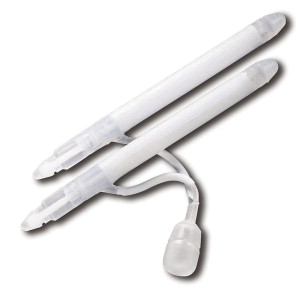
The ideal penile prosthesis would produce flaccidity and erection approaching that achieved naturally. Three-piece inflatable penile prostheses, which transfer a large volume of fluid into expandable cylinders for erection and out of the cylinders for flaccidity, approach this ideal. These devices require a fluid reservoir that is too large for the scrotum and needs to be implanted in the abdomen.
Coloplast manufactures the Titan Inflatable Penile Prosthesis ( Fig. 2 ) and the Titan Narrow-base Inflatable Penile Prosthesis. The Narrow-base implant is for small penises or for cases in which dilation is limited because of scarring from disease or previous surgery.
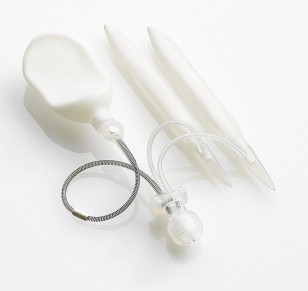
AMS manufactures the AMS 700 CX Inflatable Penile Prosthesis ( Fig. 3 ), the AMS 700 LGX Inflatable Penile Prosthesis, and the AMS 700 CXR Inflatable Penile Prosthesis. The CXR device, like the Titan Narrow-base prosthesis, has smaller diameter cylinders and is used in revision cases and less commonly in men with small penises.
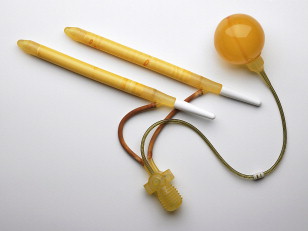
The paired corpora cavernosa of the penis consist of an outer fibroelastic tunica albuginea filled with cavernosal smooth muscle. The tunica albuginea has both inner circular and outer longitudinal elastic fibers ( Fig. 4 ). With normal erection, cavernosal smooth muscle relaxation occurs and the corpora fill with blood. The elastic fibers of the tunica albuginea allow the corpora to expand both in diameter and in length. When the elastic limits of these fibers are reached, the corpora and the penis become rigid. The ideal penile prosthesis would be undetectable while deflated, allowing a man to feel comfortable in locker rooms. With inflation, the prosthesis would create girth expansion, length expansion, and rigidity comparable to that of a normal erection. One device, the AMS 700 LGX Inflatable Prosthesis, comes closest to meeting this ideal because, in addition to girth expansion with inflation like the other three-piece inflatable devices, it also provides length expansion. In Fig. 5 , one LGX cylinder of a pair is deflated and the other is inflated. After AMS 700 LGX implantation in one patient, the pubis-to-glans tip length with the device deflated is 10.5 cm ( Fig. 6 ) and after inflation 12.5 cm ( Fig. 7 ).


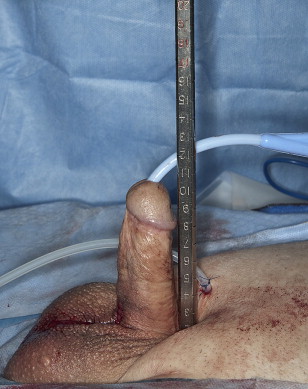
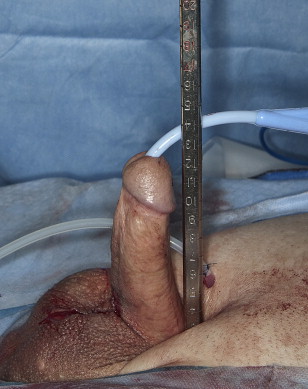
Although the AMS 700 LGX prosthesis approaches the ideal, its use is not indicated for every patient. In patients with organic ED and erectile deformity or curvature, girth only expanding CX or CXR cylinders provide better correction of deformity. In men with small penises or men with scarring due to ischemic priapism or previous penile surgery where corporeal dilation is limited, smaller diameter CXR cylinders often fit better. These cylinder applications are summarized in Table 1 .
| Small Penis | Fibrosis | Curvature | Most Others | |
|---|---|---|---|---|
| CXR | X | X | X | — |
| CX | — | X | X | — |
| LGX | — | — | — | X |
Patient selection
Formerly, specialized diagnostic testing for ED such as nocturnal penile tumescence testing, color duplex ultrasonography, and cavernosometry-cavernosography were in vogue, and their use helped provide a better understanding of the pathophysiology of ED. In 1990, Lue introduced the concept of “patient goal-directed therapy” and, since then, these tests have been largely restricted to patients who want more specific information regarding the cause of their ED.
Today, the diagnosis of ED is based largely on history. Unless there is a contraindication, such as the use of nitrates, most patients have a therapy trial with one or more of the type 5 phosphodiesterase inhibitors. If this first line of treatment is not satisfactory, patients are offered the use of a vacuum erection device, intraurethral medication, or intracavernous injection therapy. These second-line treatment options may be explored by the patient and, if satisfactory, continued. If first- and second-line treatments are not effective or the patient chooses not to try them, then penile prosthesis implantation should be considered. Penile prosthesis implantation, however, should not be done for ED that is likely to be temporary, the result of a relationship problem, or otherwise potentially reversible.
Whenever possible, it is desirable to have the partner included in these treatment discussions. In considering a man for penile prosthesis implantation, his fitness for an elective surgical procedure, his ability to give informed consent, and his manual dexterity are all issues to be considered.
Additional considerations in prospective penile prosthesis recipients include previous surgical history, a history of ischemic priapism, or the presence of erectile deformity such as Peyronie disease. Regarding the surgical history, the elements of specific importance include previous genital or penile prosthesis-related surgery; surgery for inguinal hernia repair and whether mesh was used; history of radical prostatectomy and whether it was open, laparoscopic, or robotic-assisted laparoscopic (intraperitoneal) prostatectomy; or a history of radical cystoprostatectomy.
Since penile prosthesis implantation is capable of providing only a prosthetic erection, the patient should be questioned preoperatively about his libido and the presence of orgasm with or without ejaculation.
Patient selection
Formerly, specialized diagnostic testing for ED such as nocturnal penile tumescence testing, color duplex ultrasonography, and cavernosometry-cavernosography were in vogue, and their use helped provide a better understanding of the pathophysiology of ED. In 1990, Lue introduced the concept of “patient goal-directed therapy” and, since then, these tests have been largely restricted to patients who want more specific information regarding the cause of their ED.
Today, the diagnosis of ED is based largely on history. Unless there is a contraindication, such as the use of nitrates, most patients have a therapy trial with one or more of the type 5 phosphodiesterase inhibitors. If this first line of treatment is not satisfactory, patients are offered the use of a vacuum erection device, intraurethral medication, or intracavernous injection therapy. These second-line treatment options may be explored by the patient and, if satisfactory, continued. If first- and second-line treatments are not effective or the patient chooses not to try them, then penile prosthesis implantation should be considered. Penile prosthesis implantation, however, should not be done for ED that is likely to be temporary, the result of a relationship problem, or otherwise potentially reversible.
Whenever possible, it is desirable to have the partner included in these treatment discussions. In considering a man for penile prosthesis implantation, his fitness for an elective surgical procedure, his ability to give informed consent, and his manual dexterity are all issues to be considered.
Additional considerations in prospective penile prosthesis recipients include previous surgical history, a history of ischemic priapism, or the presence of erectile deformity such as Peyronie disease. Regarding the surgical history, the elements of specific importance include previous genital or penile prosthesis-related surgery; surgery for inguinal hernia repair and whether mesh was used; history of radical prostatectomy and whether it was open, laparoscopic, or robotic-assisted laparoscopic (intraperitoneal) prostatectomy; or a history of radical cystoprostatectomy.
Since penile prosthesis implantation is capable of providing only a prosthetic erection, the patient should be questioned preoperatively about his libido and the presence of orgasm with or without ejaculation.
Informed consent
As in all surgical procedures, the type of anesthesia, the length of stay, postoperative morbidity, and length of disability are discussed. There is also a discussion of the various types of penile prostheses. Most patients in my practice choose a three-piece inflatable device and, although these provide flaccidity and erection coming closest to the natural states, there are important differences. The penile prosthesis will only treat ED. If libido, orgasm, or ejaculation are impaired, they may be absent or impaired after the implant. I tell the patient that most men with three-piece inflatable devices will feel comfortable in a locker room. The erection produced by a three-piece device differs from a normal erection in that the glans does not increase in size. In the examination room, I demonstrate, for the patient and partner, his stretched penile length and tell him (them) that this will be the approximate length of his prosthetic erection. For most men, this is somewhat shorter than he would expect and for some men it is much shorter. Men in the latter category include those after radical prostatectomy where loss of penile length has been well documented. Also in this category are men who have a history of ischemic priapism, Peyronie disease, removal of an infected penile implant, and some men who are obese. This issue of length is most important because, in my experience, if a man has had a successful implant and is unhappy, it is usually because the prosthetic erection is shorter than he expected.
Infection is the bane of penile prosthesis surgery because, if it is present in the space around the implant, total removal of all prosthetic material will be required. Penile prosthesis reimplantation in these men is frequently difficult due to fibrosis of corporeal smooth muscle, which also makes the penis permanently smaller. Internal erosion of the cylinders often requires revision surgery. External erosion of the prosthesis is usually the result of infection. Although men who have a penile prosthesis removed for reasons other than infection might still be able to have successful treatment for their ED using a vacuum erection device or intracavernous injection therapy, penile prosthesis implantation still has the potential, especially if infection occurs, of destroying any residual erectile tissue. Penile prostheses can fail mechanically, and the likelihood of this occurring is discussed below.
Stay updated, free articles. Join our Telegram channel

Full access? Get Clinical Tree





